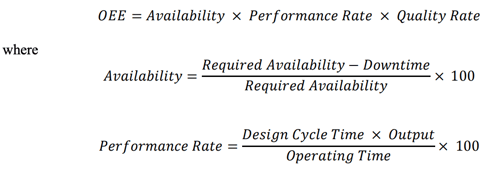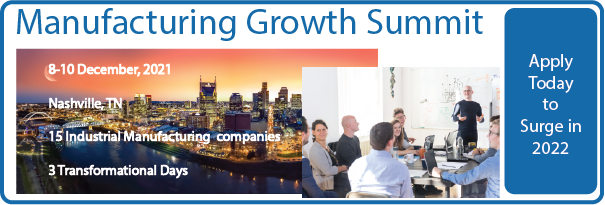Tl;dr - Industrial companies use the concept of OEE to improve their production performance. They often fail to apply the same rigor to their revenue growth function. ORE™ is an analogous process that can be applied to improve B2B sales and marketing.
What is ORE Overall Revenue Effectiveness?
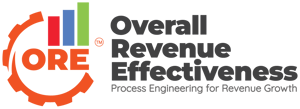 Overall Revenue Effectiveness™ is a methodology B2B Sales companies can use to measure component contribution and aggregate effectiveness of their revenue growth operations.
Overall Revenue Effectiveness™ is a methodology B2B Sales companies can use to measure component contribution and aggregate effectiveness of their revenue growth operations.
The concept will be familiar to manufacturers that use OEE (overall equipment effectiveness) to optimize manufacturing lines. OEE.com says "it identifies the percentage of manufacturing time that is truly productive....Measuring OEE is a manufacturing best practice."1 The National Institute for Standards and Technology (NIST) says "Overall equipment effectiveness (OEE) is defined as...Availability * Performance Rate * Quality Rate."2
One of the core insights from OEE analysis is that small inefficiencies compound. In other words a manufacturing line with 10 machines/functions, each of which operates at 98% efficiency, cumulatively only operates at <82% efficiency.
That's sobering.
And it's directly applicable to B2B sales which is much like a complex manufacturing line in that it's a sequential progression of steps. (Although the buying journey isn't linear, we know that executing deals involves numerous steps which generally occur in a fixed order.) Each of those steps has inherent inefficiencies that cumulatively result in a revenue growth process that is shockingly inefficient. (Just think about the difference between a 10% and 35% close rate!!)
Let's look at the B2B sales analog to NIST's OEE definition of "Availability * Performance Rate * Quality Rate."
High-Level Steps in B2B Sales for Efficiency Optimization
What are typical revenue growth steps (subject to ORE analysis)?
- Understanding buyers and markets - you have to start with quality materials. Building anything upon low-quality inputs will result in low-quality output, regardless of precision in the process. In ORE this means:
- ideal Customer Profile (ICP) - the right type of companies to sell to
- buyer Personas and complex buying teams - who's involved and what each want/expect from the outcome and the process
- market trends
- your buyers' buyers - knowing what will make your buyers successful by understanding theirs
- problems that you solve, the cascading implications, and the common cost reduction/revenue growth that you facilitate through those solutions
- product market fit, pricing, and roadmap
- The Structure or System design - building the right process.
- appropriate investment in revenue growth team (and appropriate allocation between marketing and sales functions)
- defining the right skills and attributes and hiring the right people
- consistent reviews against meaningful metrics
- the ability to measure and report meaningful metrics
- cost/lead
- cost of customer acquisition
- lifetime value
- close rate
- sell cycle
- etc.
- sales model (inside, outside, BDR, indirect channel, PLG (product-led growth), etc.)
- outsource elements and expertise
- tech stack
- Culture & Accountability
- establishing clear priorities and deadlines
- collaboration
- expectations of superb performance and support to achieve it
- swift resolution to lack of accountability and inadequate performance
- The Story - You have to clearly articulate why it matters and how it helps. This underlies effective inbound marketing, outbound sales, sales enablement and more.
- branding
- copywriting
- messaging
- customer experience
- Inbound marketing
- keyword research
- content creation
- technical SEO
- search rankings
- click through rates
- visitor to lead conversion rates
- landing page/form conversion rates
- chatbot conversion rates
- Outbound marketing and sales
- inbound lead qualification and follow up
- email
- frequency
- delivery
- open & click
- engagement and forwards
- data stack accumulation and maintenance
- target identification
- omnichannel cadence design and execution
- sales enablement
- Sales
- defined process
- rigorous execution
- qualification, pipeline management, project management
- forecasting
Obviously, success and onboarding are critical as well, but similar to customer service and logistics would not correlate to the actual line efficiency.
Each Step Compounds Any Issues with All Preceding Steps
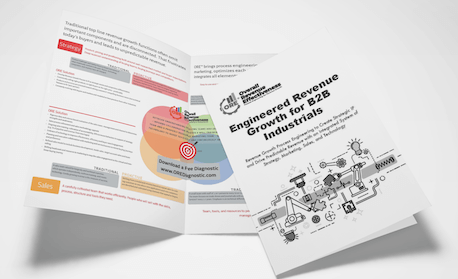 While buying journeys are complex, engineering the B2B sales approach can be viewed as a linear design challenge. And inefficiencies at each step are subsequently magnified.
While buying journeys are complex, engineering the B2B sales approach can be viewed as a linear design challenge. And inefficiencies at each step are subsequently magnified.
Inadequate (often based on assumptions rather than qualitative and quantitative research) understanding of buyers and markets will inexorably lead to improper product roadmaps, value propositions, and positioning.
Companies that aren't clear what they should be selling to whom will naturally focus on inefficient keywords and content.
Poorly founded content will lead to low visitor-to-lead conversion rates.
Low conversion rates will lead to higher spending to generate leads in other ways.
Poorly qualified leads will lead to low lead to project conversion rates and wasted time on poor leads.
Lead and project flows, distorted by inappropriate inclusions, will result in inefficient staffing resource decisions.
Ineffective sales enablement content and b2b sales reps who aren't facile with data and technology will reduce close rates.
Sales process which doesn't accommodate contemporary buyer behaviors and complex buying teams will lengthen B2B sales cycles and impair forecasting, particularly when culture doesn't encourage precision and rigor.
Inaccurate forecasting will impinge on the company's financial and operational effectiveness.
Unfocused revenue operations will fail to eliminate waste in the process.
Incrementally Improving Efficiency in Each Step
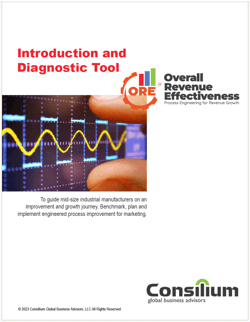 Inefficiency at each step compounds throughout each subsequent step. Proper KPIs can identify these inefficiencies, and upgrades in process and technology, supported by cultural changes, can improve results.
Inefficiency at each step compounds throughout each subsequent step. Proper KPIs can identify these inefficiencies, and upgrades in process and technology, supported by cultural changes, can improve results.
Marketing and sales alignment is an apt example. When marketing has a goal of delivering a certain number of MQLs (marketing qualified leads) and sales has a performance metric of "quoting" then those disconnected objectives naturally lead to disconnected activity. And the disconnected activity leads to a buyer experience that fails to meet expectations.
The typical response of management is to focus on specific points along this continuum. They may seek to improve SEO or train on sales rep presentation skills for instance. And while either of those, or countless other points, may offer fruitful opportunities for improvement, if they're done in isolation - without the full context of the revenue growth system - they'll fail to deliver transformative change.
The focus on specific points is ONLY appropriate in the context of a complete systems perspective.
A Deeper Dive into Overall Revenue Effectiveness
It's helpful to understand ORE at a high level and visualize it's analog in OEE. It's also important to understand some of the details of how it works and how you can apply it to your business. Download this free diagnostic which outlines the four pillars, numerous categories and 199 areas of focus in the ORE Framework.
Four Pillars of ORE
 ORE is built around four pillars. Let's look at each in more detail.
ORE is built around four pillars. Let's look at each in more detail.
Company, Board, and Strategy
The company's strategy must be clear and well defined. Uncertainty, vagueness and weak oversight at this level translate into inefficiency in the following process steps. Marketing messaging and tactics are dictated by the strategy. Goals for total revenue are driven by the board and management. Everything else in the system flows from this.
Manufacturing Marketing
Marketing costs and methods must be appropriate for the business, and built around the board's strategy with data driven decisions. The implementation of various marketing approaches, and the KPIs by which they're measured and managed are all determined by strategy, and must support the total revenue goals which sales carry.
Industrial Sales
Buyers and buying habits are changing....quickly. Prospects are carefully monitoring capital and operating expenses. Buyers often work in the shadows. Sales tactics and approaches must be built on the strategy and marketing, and focused on improving the buyer experience. This can reduce the sales cycle while helping the team generate more revenue.
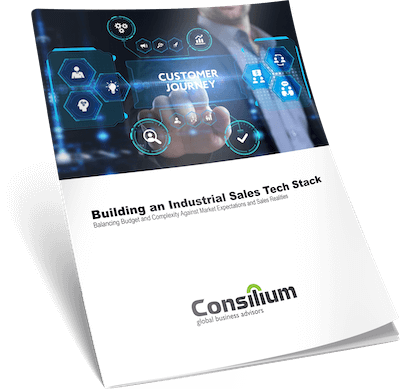 Marketing and Sales Technology
Marketing and Sales Technology
Let's face it - buyers expect great experiences, mostly online, and modeled after their B2C experiences. Your marketing and sales technology stack must deliver those, and provide sales teams with tools to boost their efficiency.
The ORE framework considers these four pillars, across 23 categories and 199 specific areas of focus, improvement and sales efficiency gains.
B2B Sales is a Complex Engineered System Like a Production Line
Most executives track revenue as their primary performance metric. That's similar to considering just total output at the end of a year.
That single metric obscures many opportunities for dramatic improvement in single areas and compounding small improvements in many areas - important because they compound. But why does that dissonance exist between the way they manufacture and the way they sell?
The gap is normally attributable to the absence of an integrated framework. That absence is an understandable vestige of the traditional bifurcation of responsibilities in the legacy marketing and sales functions of capital equipment and other industrial manufacturers.
While it's understandable, it's also a liability in today's market where buyers have been conditioned to have consumer-grade online experiences and where buying teams and processes are so complex.
That critical framework will be the focus of our December Manufacturing Growth Summit where we'll help companies build it and then return to their offices to implement it for transformative 2022 results.
1. https://www.oee.com/
2. https://nvlpubs.nist.gov/nistpubs/ams/NIST.AMS.100-18.pdf
